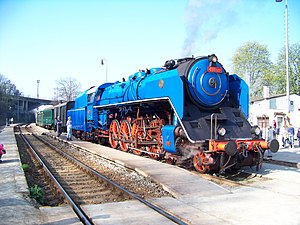ČSD series 498.0
| ČSD series 498.0 | |
|---|---|
| Numbering: | ČSD 498.001-040 |
| Number: | 40 |
| Manufacturer: | Škoda , Plzeň |
| Year of construction (s): | 1946-1947 |
| Retirement: | until 1976 |
| Axis formula : | 2'D 1'h3 |
| Gauge : | 1435 mm ( standard gauge ) |
| Length over buffers: | 24,950 mm |
| Length: | 16,364 mm |
| Fixed wheelbase: | 5,790 mm |
| Total wheelbase: | 12,550 mm |
| Wheelbase with tender: | 21,120 mm |
| Smallest bef. Radius: | 150 m |
| Empty mass: | 96.3 t |
| Service mass: | 106.1 t |
| Service mass with tender: | 175.0 t |
| Friction mass: | 72.0 t |
| Wheel set mass : | 18 t |
| Top speed: | 120 km / h |
| Indexed performance : | 1,626 kW |
| Driving wheel diameter: | 1,830 mm |
| Impeller diameter front: | 880 mm |
| Rear wheel diameter: | 1,308 mm |
| Number of cylinders: | 3 |
| Cylinder diameter: | 500 mm |
| Piston stroke: | 680 mm |
| Boiler overpressure: | 16 bar |
| Number of heating pipes: | 134 |
| Heating pipe length: | 6,000 mm |
| Grate area: | 4.7 m² |
| Radiant heating surface: | 19.12 m² |
| Tubular heating surface: | 238.5 m² |
| Superheater area : | 73.8 m² |
| Evaporation heating surface: | 257.62 m² |
| Tender: | 935.0 |
| Water supply: | 26 m³ |
| Fuel supply: | 14.9 m³ |
| Brake: | Hand brake Air brake Westinghouse / Bozic G / P |
| Control: | Heusinger |
The CSD series 498.0 was a series of fast - Tender locomotives of the former Czechoslovak State Railways (CSD). Because of their elegant appearance, they were nicknamed Albatros by the operations service .
history
The class 498.0 locomotives were built after the Second World War, when there was a great need for locomotives to connect large cities, especially since the last express train design was from 1938 ( ČSD class 486.0 ). The locomotive was therefore designed with the order date October 6, 1945 as a further development of this proven express locomotive at Škoda in Plzeň . Compared to the "Green Anton" , the locomotive showed considerable improvements.
The locomotive frame was designed as a bar frame with 90 mm thick frame cheeks. All drive and coupling wheels ran in centrally lubricated slide bearings. The locomotive boilers were welded, only the first locomotive boilers were partly riveted. The tilting grate was operated from the driver's cab. The fire door was opened and closed pneumatically by means of a foot lever. The Heusinger control worked with internal flow and was reversed with the help of a pneumatic servo motor. The wings ran in roller bearings.
The locomotives were given a red coloring for the wheels and the frame, a blue coloring for the boiler and the driver's cab and a white coloring for the driver's cab roof.
The locomotives achieved great national and international attention due to their performance. In scheduled service, they carried the heavy express trains with loads over 600 t, but were also universally applicable. During the acceptance runs, they carried scheduled express trains with a load of 600 t at top speeds of up to 136 km / h. Their use made it possible to shorten the travel times of the heavy express trains considerably; on the Prague - Přerov route by 20 minutes, on the Prague - Bratislava route by 40 minutes. However, these services put a strain on the locomotives and the staff, which often led to delays. During operation, tests were carried out on the machines with the Kylchap double blow pipe . This then led to the procurement of the 498.1 series , which represents the high point of steam locomotive construction in Czechoslovakia. The machines were subsequently given a stoker fire.
With the electrification of the most important main lines at the ČSD , the locomotives were withdrawn to non-electrified lines and their numbers slowly declined. In 1969 27 locomotives were still in use, in 1972 there were 4 machines that were in service in the Plzeň depot and were replaced here by the T 478.3 series diesel locomotives .
The last “Albatros” to be retired in 1976 was 498,022. 498.022 was preserved and is looked after as an operational museum locomotive of the ČD in Praha-Smíchov .
See also
literature
- der Modellisenbahner 5/1970 - Vehicle archive
- Helmut Griebl: ČSD Steam Locomotives , Vienna, 1969
Web links
- Website for the 498.0 series (Czech)
- Website of Škoda locomotives ( Memento from September 27, 2007 in the Internet Archive )
- Company photo of the 498.020 from 1966 on k-report.net
